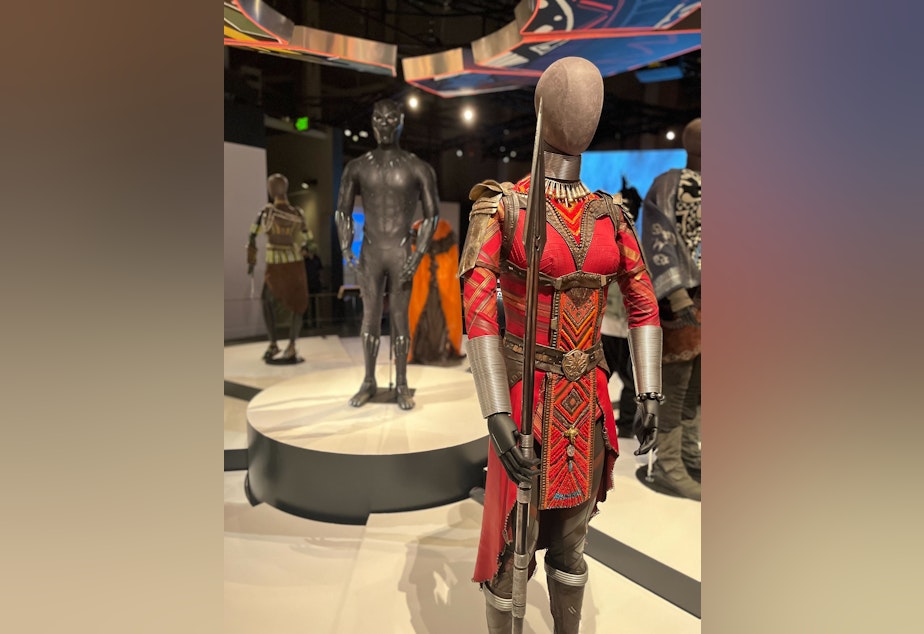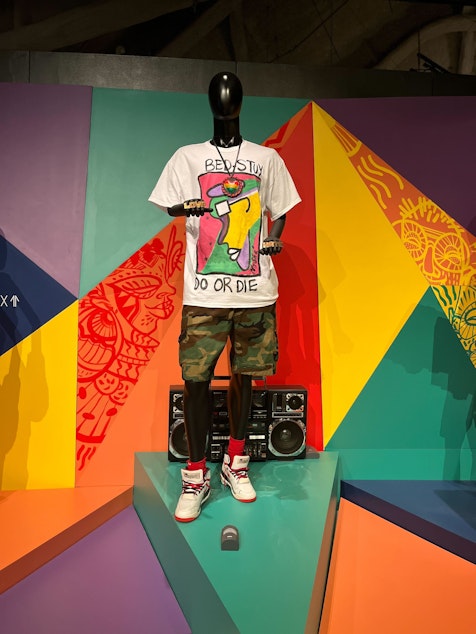'It's an ongoing celebration:' Ruth E. Carter on the cultural impact of her Afrofuturistic costume designs

The Marvel film "Black Panther" has a lot to amaze audiences — stunning CGI, a roster of A-List actors. But the finer details that make Wakanda what it is aren't acted, or computer generated. They're sewn together, stitch by stitch, by an entire team off-screen.
Ruth E. Carter won an academy award for her costume work on "Black Panther," and she has a resume that spans decades of legendary film work, including "Malcolm X," "Amistad," "Selma," and "Do The Right Thing."
Carter's work is on display right now at the Museum of Pop Culture (MoPop) in an exhibit titled, "Afrofuturism in Costume Design."
KUOW arts and culture reporter Mike Davis went to see the exhibit and spoke with Carter about the generational inspirations and impacts of her work, from the ancestral designs that define the costumes in "Black Panther" to the sneaker culture influences of Spike Lee in "Do the Right Thing."
"I feel so blessed to have been able to take a passion that I had for telling stories — for telling stories about African Americans, for telling stories about the diaspora...to have projects that enabled me to delve deep into the history, the culture, the passion, the love, and express that in so many ways," Carter said.
Carter said she draws inspiration for her work, in part, by imagining the experiences of the characters she dresses.
Sponsored
"I think [of] films like 'Malcolm X' and looking at images of Harlem in the 1940s, and really wanting to connect the images of his journey to the places that he went, and the places that I saw, and the energy that I felt when I walked through the streets of Harlem," she said. "And the same is for Brooklyn, Bed-Stuy in 'Do the Right Thing.' I felt a kinship. And I wanted that kinship to be expressed in the clothing that everyone wore in the film — that it was a community, it was a family."
Carter also described how studying the history of an era she's portraying is a key part of her creative process.
"Historical accuracy is first, and understanding...why people wore what they wore, how they wore it, what fabrics they had available, how they dyed the cloth, how they spun the cloth," she said. "The awareness of that leads you through your first phase of the process."
But when it comes to understanding the fashion of a given era, images alone can be misleading, Carter said.
"A lot more is written than you actually can see in photographs, or etchings, or paintings," she said. "I work with historians that make reading recommendations. They tell us how sometimes, what we look at is deceiving — we are receiving it with these eyes that are modern, that are contemporary."
Sponsored
"So you really do have to do the research on what you're looking at," Carter added. "You can't take things for face value."
Carter also spoke to how the passion that goes into costuming and storytelling transfers to an audience.
"Advisors that I've had, teachers that I've had, they would always tell me that you can put your heart and soul into something and no one's really going to read your heart and soul — they're going to feel your heart and soul."
The cosplay seen among fans of the "Black Panther" film franchise is a case in point. For fans who are part of the African diaspora in particular, wearing Afrofuturistic clothing inspired by Carter's designs has become a symbol of connection to a place of shared origin.
"It's an ongoing celebration," Carter said about seeing people embrace the fashions of Wakanda. "And I feel like we love the celebration of culture, we love to celebrate ourselves. And this way, we were able to connect to a really deep-seated root, and that is the place where we have all come from."
Sponsored
Click the audio above to hear Mike Davis' trip to MoPop and his conversation with Ruth Carter.









